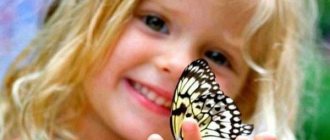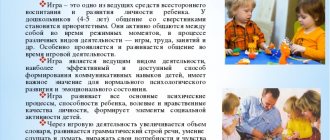Role-playing game based on the Russian folk tale “Kolobok” for children of the middle group
Theatrical activities. Role-playing game based on the Russian folk
tale “Kolobok” (for children of the middle group) Purpose:
to develop in preschool children the skills of safe behavior in the environment, communication skills through role-playing games.
Tasks:
- consolidate children’s previously acquired knowledge about the rules of behavior and communication in role-playing games;
- develop the ability to play according to one’s own plans, encourage children’s creative activity in play;
- consolidate knowledge and skills of cultural behavior in public places (theater);
- develop analytical and synthetic activities based on situation analysis;
- develop dialogical speech, contribute to the enrichment of passive and active vocabularies;
- cultivate a culture of behavior and communication.
Attributes for the game:
complimentary ticket;
costumes for the dramatization of the fairy tale “Kolobok”; game character masks; children's tables and chairs, poster; tickets to the performance in the form of cut-out pictures depicting a bun, grandfather, grandmother, hare, bear, wolf, fox; forest decoration (trees, mushrooms, stump, flowers); emoticons in the form of a bun. Vocabulary work:
poster, auditorium, intermission, stranger, rules of communication, culture of communication.
Methods and techniques:
creating a game environment, staging a fairy tale, conversation, highlighting a problem situation, modeling communication situations, elements of brainstorming, play, reflection.
Preliminary work:
- production of posters, tickets;
- reading the fairy tale “Kolobok”;
- drawing based on the fairy tale “Kolobok”;
- role-playing game "Theater";
- guessing riddles about animals;
- examination of illustrations for the fairy tale “Kolobok”;
- classes on rules of behavior and communication.
Pedagogical development of the game plan:
- Creating a gaming moment using an invitation ticket to the theater.
- Developmental exercise “Cut pictures”.
- View a dramatization of a fairy tale.
- Conversation on the content of the fairy tale.
- Identification of a problem situation.
- An element of “brainstorming” with the search for a solution to the situation.
- Distribution of playing roles taking into account the interests and wishes of children.
- Acting out communication situations suggested by children.
- Game analysis.
- Reflection.
Progress of the role-playing game:
- Familiarize children with the game plan.
The teacher-psychologist informs the children about the game plan: “Guys, I know that you really love fairy tales. Today we will visit a real theater, where we will watch a play, reflect on its content, the behavior of the main character, and become participants in a fairy-tale game ourselves.”
- Creating an imaginary situation.
The teacher-psychologist shows the children an invitation card: “Guys, today an invitation card arrived at our kindergarten. You and I are invited to visit the theater. But before you go to the theater, you need to remember the rules of conduct in it.”
Children voice the rules of behavior in the theater:
— Enter the auditorium before the start of the performance.
- Do not make noise during the performance. — Before the performance, turn off mobile phones. — Artists are greeted and seen off with applause. - Walk to the spectator seat facing those who have already taken their place. — During the intermission, you can leave the hall and visit the buffet. Together with a teacher-psychologist, children go to an imaginary auditorium where forest scenery is displayed. Developmental exercise “Cut pictures”.
The educational psychologist reports: “At the entrance to the auditorium, everyone must present an entrance ticket.
To get such a ticket, you must collect cut pictures from several parts. Each of you has your own split picture. The pictures will help us guess what kind of performance we will watch. Children collect cut-out pictures. Brief conversation:
- Guys, what characters did you create for the play?
(grandmother, grandfather, bun, hare, wolf, bear, fox). - What fairy tale will we watch? (“Kolobok”). You and I will knock quietly on the house. Grandma will feed you - the pies are in the oven. Grandfather will tell us about Kolobok. How Baba once baked it. The teacher-psychologist shows the children a poster for the fairy tale “Kolobok” and invites the children to take seats in the improvised auditorium. A dramatization of the fairy tale “Kolobok” (performed by children of the middle group). Conversation:
- Guys, where did Kolobok come from in the fairy tale? (grandmother baked it).
- Who did Kolobok meet in the fairy tale? (children list animals).
- What happened to Kolobok in the fairy tale? (he was eaten by a fox).
- Why did it happen? (the bun did not listen to his grandparents, he communicated with unfamiliar animals, the fox deceived him).
Children identify the problem
:
Kolobok behaved incorrectly with strangers. Elements of brainstorming.
The teacher-psychologist invites the children to come up with situations of communication with animals in which Kolobok would not be harmed.
Expected answers from children:
- Do not leave home without warning adults.
- Do not boast about your behavior in front of strangers. - Deal with animals politely. - Don't talk to strangers. - Make friends with animals. - Do not walk alone in the forest, in an unfamiliar place. — When meeting strangers, call for help. During the discussion, the educational psychologist clarifies each answer option.
- Distribution of roles.
The educational psychologist clarifies the children’s desire to fulfill a particular role. All roles go to children. During the game, the educational psychologist plays the role of coordinator and assistant, suggesting situations from a fairy tale for execution.
- A game.
During the game, children act out situations from a fairy tale:
- communication with grandparents, where grandparents do not leave Kolobok unattended, tell him the rules of walking and communication;
- communication with animals;
- call for help;
- inviting animals to take a walk together.
- Ending the game.
The teacher-psychologist invites children to formulate rules of behavior and communication.
Suggested rules:
- Adults should not leave children unattended.
- Don't communicate with strangers.
- Don't be on the street alone.
- Don't trust strangers.
- If an emergency occurs, call for help.
Reflection:
The teacher-psychologist invites children to choose emoticons in the form of a kolobok with the mood that matches the mood of the children in the game.
MAGAZINE Preschooler.RF
Leisure activities for children of the 2nd junior group “Kolobok” (with the participation of parents)Teachers of GBOU secondary school No. 1935 Gubanova M.V.,
Tasks:
- developing children’s ability to reflect certain game actions and imitate actions and characters, convey simple emotional states of characters, using at least one means of expressiveness - facial expressions, gesture, movement.
- encourage children to actively participate in theatrical play.
- develop the ability to coordinate actions with other children
- activate children's speech.
- develop auditory attention and imagination
- consolidate children's knowledge about animals
- continue to introduce children to Russian folk tales.
- continue to teach children to sculpt from salt dough
Vocabulary work:
Runaway bunny, gray flank top, clumsy bear, sister fox. bun
Preliminary work:
Guessing riddles about animals. Reading the Russian folk tale “Kolobok” and a conversation about its content, showing the fairy tale “Kolobok” on a magnetic board, imitating and imitating the heroes of the fairy tale (the hare jumps, speaks in a high voice, the bear - clubfoot - speaks in a bass voice, etc.), listening to a song T. Morozova “Kolobok” , display of the table theater “Kolobok” , during classes in modeling, appliqué, art activities and in everyday life, display the heroes of the fairy tale “Kolobok”
Methodical techniques:
Playful, surprise moment, showing, comparison, questions, acting out.
Materials and equipment:
“wonderful box, magnetic board, pictures based on the fairy tale “Kolobok” , screen, sound-reproducing equipment, sound recording of T. Morozova’s song “Kolobok” , bi-ba-bo toys - kolobok, hare, wolf, bear, fox, grandmother costumes and dedki, stacks, salted dough, dough molds.
Leisure activities:
Educator: Guys! Today guests came to us, they want to see how you have grown, how you are doing, how well done you are. They also want to participate in our lesson. Let's give our guests the magic word: “Hello!” Now let's smile and give everyone a joyful mood!
Educator: Guys, I was walking along the path towards you and found a beautiful box. (tries to open the lid of the box) Oh, the box won’t open. Probably the box is not simple but magical! I wonder what is hidden in it? Maybe there is a fairy tale hidden in it? Do you know fairy tales? What fairy tales do you know? (children's answers) I will tell you riddles about the heroes of the fairy tale. If you guess them correctly, then the fairy tale will come to visit us.
Puzzles:
1. He rushes without looking back, only his heels sparkle. Quickly guess who it is? (Bunny)
2. Day and night he scours the forest, looking for prey for himself, and when he finds it, he snaps his teeth! - And the hungry one will eat...
(Wolf)
3. In winter he sleeps, sucks his paw, and in summer he eats sweet honey? (Bear)
4. Cunning cheat, red head. The fluffy tail is beautiful! What is her name? (Fox)
5. It is shaped like a ball. He was once hot. He jumped off the table onto the floor and left his grandmother. He has a ruddy side... Did you recognize it? (BONK)
(as you solve the riddles, take the bi-ba-bo toy out of the box and put it on the table)
Educator: Well done! We solved all the riddles, that's how many toys the magic box gave us. Guys, how many of you guessed which fairy tale characters came to visit us? (gingerbread man)
Correctly "Kolobok" . I also really liked this fairy tale as a child.
Now I will turn into a storyteller grandmother (puts on a shawl and glasses) and tell you a fairy tale. Listen here (the kids sit on chairs in front of the screen, and at this time the parents hide behind the screen with be-ba-bo toys, grandma and grandpa appear on both sides of the screen, and the fairy tale begins)
Kolobok
Once upon a time there lived an old man and an old woman.
So the old man says to the old woman:
“Come on, old woman, scrape the box, mark the bottom, see if you can scrape some flour into a bun.”
The old woman took the wing, scraped it along the box, swept it along the bottom and scraped up two handfuls of flour.
She kneaded the flour with sour cream, made a bun, fried it in oil and put it on the window to cool.
The bun lay there, lay there, took it, and then rolled - from the window to the bench, from the bench to the floor, on the floor to the door, jumped over the threshold - and into the entryway, from the entryway to the porch, from the porch to the yard, from the yard through the gate, further and further.
Kolobok is rolling along the road, and the Hare meets him:
- Kolobok, Kolobok, I will eat you!
- Don’t eat me, Hare, I’ll sing you a song:
I am Kolobok, Kolobok, I am scraping the box, sweeping the bottom of the barrel, Meshon on sour cream, Yes, pryazhon in butter, Stuzhon on the window. I left my grandfather, I left my grandmother, I’ll leave you, the hare, even more so!
And he rolled down the road - only the Hare saw him!
Kolobok rolls, the Wolf meets him:
- Kolobok, Kolobok, I will eat you!
- Don’t eat me, Gray Wolf, I’ll sing you a song:
I am Kolobok, Kolobok, I am scraping the box, sweeping the bottom of the barrel, Meshon on sour cream, Yes, pryazhon in butter, Stuzhon on the window. I left my grandfather, I left my grandmother, I left the hare, I’ll leave you, wolf, even more so!
And he rolled down the road - only the Wolf saw him!
Kolobok is rolling, the Bear meets him:
- Kolobok, Kolobok, I will eat you!
- Where can you, clubfoot, eat me!
I am Kolobok, Kolobok, I am scraping the box, sweeping the bottom of the barrel, Meshon on sour cream, Yes, pryazhon in butter, Stuzhon on the window. I left my grandfather, I left my grandmother, I left the hare, I left the wolf, I’ll leave you, bear, even more so!
And he rolled again - only the Bear saw him!
Kolobok rolls, the Fox meets him:
- Kolobok, Kolobok, where are you going?
- I'm rolling along the path.
- Kolobok, Kolobok, sing me a song!
Kolobok sang:
I am Kolobok, Kolobok, I am scraping the box, sweeping the bottom of the barrel, Meshon on sour cream, Yes, pryazhon in butter, Stuzhon on the window. I left my grandfather, I left my grandmother, I left the hare, I left the wolf, I left the bear, It’s easy to leave you, fox!
And Lisa says:
- Oh, the song is good, but I can’t hear well. Kolobok, Kolobok, sit on my toe and sing one more time, louder.
Kolobok jumped up on the Fox's nose and sang the same song louder.
And Lisa told him again:
- Kolobok, Kolobok, sit on my tongue and sing for the last time.
The bun jumped on the Fox's tongue, and the Fox made a noise! - and ate it. That’s the end of the fairy tale, and whoever listened - well done!
Educator: Guys, did you like the fairy tale? Let's remember the characters of the fairy tale again.
Word game: the teacher says the beginning of the sentence, the children finish it.
I am Kolobok, Kolobok, I am scraping the box, sweeping the bottom of the barrel, Meshon on sour cream, Yes, pryazhon in butter, Stuzhon on the window. I left my grandfather, I left my grandmother, I left the hare, I left the wolf, I left the bear, It’s easy to leave you, the fox.
Educator: Well done! Now let’s, together with our guests, make our own koloboks from the dough. Children and parents sit down at the tables and get to work. After making the koloboks, we examine them.
Educator: You and I have worked very hard, now we can rest. Let's all dance together. (T. Morozova “Kolobok” )
Educator: That's how fun we danced. This is where the fairy tale ends, and whoever listened, well done!
| Next > |





